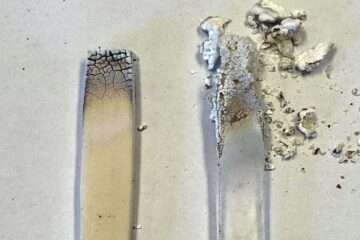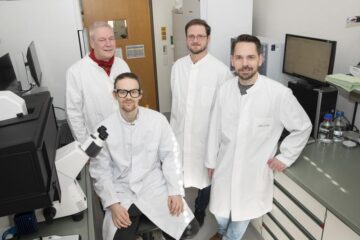Chemists create synthetic cytochromes

When animals metabolize food or when plants photosynthesize it, electrons are moved across cell membranes. The “extension cords” of this bioelectrical circuit are mostly iron-containing proteins called cytochromes.
Chemist Kenneth S. Suslick and colleagues at the University of Illinois at Urbana-Champaign have created synthetic cytochromes by making a small cyclic peptide that binds to the iron millions of times more strongly than without the peptide. The scientists report their discovery in a paper in the Oct. 23 issue of the Journal of the American Chemical Society.
Cytochromes are heme proteins; that is, the iron is held in the central hole of a doughnut-shaped heme. Related to hemoglobin and myoglobin — the red-colored proteins that carry and store oxygen in blood and muscles — cytochromes carry electrons rather than oxygen atoms.
“The heme is held very tightly in heme proteins, most commonly by bonds between the iron ion and the amino acid histidine,” said Suslick, a William H. and Janet Lycan Professor of Chemistry at Illinois. “This bond is much stronger in proteins than it is for a heme binding free histidine. This makes cytochromes among the most stable of all proteins.”
Suslick and his colleagues expected that a cyclic peptide would hold on to the iron ion heme like a tight ring on a finger. In fact, the researchers found that their cyclic peptide binds to heme 6,000 times more strongly than to two half-sized peptides that are not linked together, and 4 million times more strongly than histidine itself.
“Most of this effect is called ’preorganization,’” Suslick said. “By preforming the peptide ring, we make it much easier for the peptide to bind the heme. In addition, the heme stabilizes the structure of the cyclic peptide by making it fold into a perfect helix.”
The synergism of these effects helps explain the important role that heme plays in making heme proteins so very stable. The heme holds the protein structure together at the same time that the protein holds onto the heme.
Such synthetic cytochromes may have pharmaceutical uses in the future.
“These heme-peptides are likely to carry electrons and ions across cell membranes,” Suslick said. “This could make them very effective antibiotics, many of which kill bacteria by just this kind of transport.”
Media Contact
More Information:
http://www.uiuc.edu/All latest news from the category: Life Sciences and Chemistry
Articles and reports from the Life Sciences and chemistry area deal with applied and basic research into modern biology, chemistry and human medicine.
Valuable information can be found on a range of life sciences fields including bacteriology, biochemistry, bionics, bioinformatics, biophysics, biotechnology, genetics, geobotany, human biology, marine biology, microbiology, molecular biology, cellular biology, zoology, bioinorganic chemistry, microchemistry and environmental chemistry.
Newest articles

Trotting robots reveal emergence of animal gait transitions
A four-legged robot trained with machine learning by EPFL researchers has learned to avoid falls by spontaneously switching between walking, trotting, and pronking – a milestone for roboticists as well…

Innovation promises to prevent power pole-top fires
Engineers in Australia have found a new way to make power-pole insulators resistant to fire and electrical sparking, promising to prevent dangerous pole-top fires and reduce blackouts. Pole-top fires pose…

Possible alternative to antibiotics produced by bacteria
Antibacterial substance from staphylococci discovered with new mechanism of action against natural competitors. Many bacteria produce substances to gain an advantage over competitors in their highly competitive natural environment. Researchers…





















